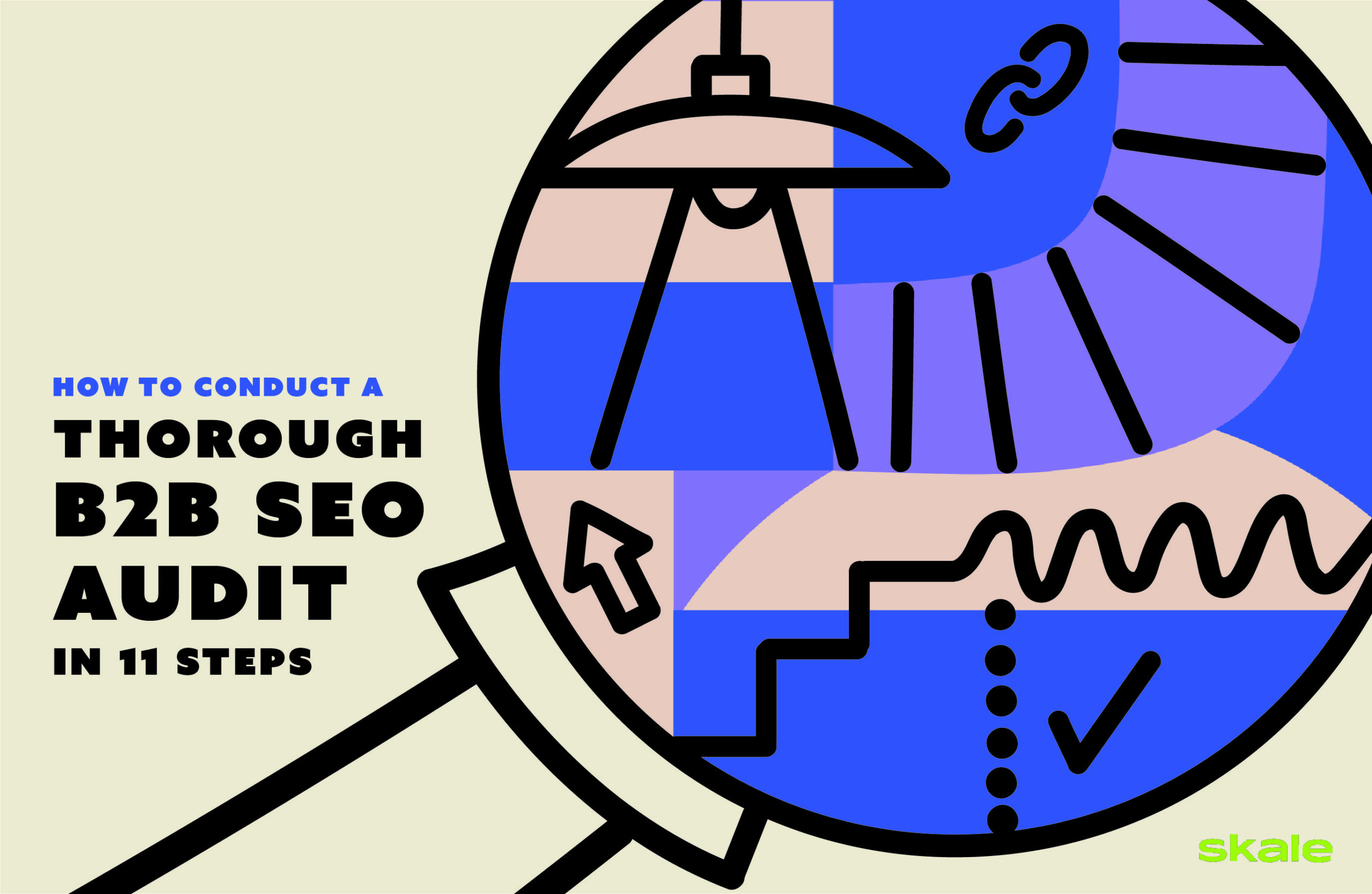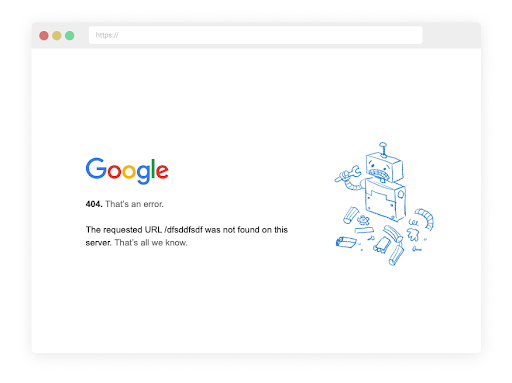
The Power of Partnership: 7 Benefits of Hiring a B2B SEO Agency
These benefits of hiring a B2B SEO agency illustrate why outsourcing your content can help you to drive new revenue for your business.


Level up your SEO strategy with Skale
See where Skale’s SEO experts can take your MRR- get in touch today
Schedule a callYou’ve seen the huge success brands have achieved through B2B search engine optimization and you’re ready to recreate it. You know where to start, right?
You got it, with a B2B SEO audit.
A B2B SEO audit is an auditing of all the SEO aspects of your website and content strategy that’ll have an impact on your search visibility and conversion rates.
Technically put, it’s about understanding how search engines are perceiving your content and give you the insights needed to get a higher seat on their search results rankings and better hit user search intent.
In this article, we’ll show you how to conduct an SEO audit focusing on two key aspects:
We’ll explore what you need to check and how you can improve on your findings.
Let’s get auditing.
Let’s find out what we need to know before we start our audit.
There are a few elements you should consider before starting the auditing process.
SEO doesn’t work by itself; your efforts will be in a constant battle against your competitors’ efforts and the latest SEO trends. It’s always a good idea to see what the competition is doing, and more importantly, how they’re doing.
However, before analyzing your competitors, their rankings, keywords, and holistic SEO strategy, you need to find out who they actually are. There are direct and indirect competitors, but when fighting for first place on search engine results pages (SERPs) you ideally want to gauge direct competitors.
When performing a B2B SEO competitor analysis of your direct competition you’ll discover:
Now that you know why you should consider your competitors, these are the general steps you should follow when running a competitor analysis:
Another important thing to consider before diving into your B2B SEO audit is the goals and objectives that you have for your digital marketing and for this specific SEO audit, you’re about to do. After all, audits are not one-size-fits-all.
Of course, you might think: “but isn’t it obvious that we all just want more customers and profitability?” Well, the way you get there might be different.
Maybe you want to migrate your website to another domain, or you want to get more organic traffic to your landing pages, or maybe you want to rank higher in a few high-intent relevant keywords–each of these will have a different focus on your SEO audit and overall strategy.
So pinpoint your goals and outline your KPIs and milestones for you to get there.
Now you understand what your competitors are doing and you have specified what your goals are. It’s now time to see the 11 steps, divided into the categories ‘Content’ and ‘Technical’ SEO, to conduct a thorough B2B SEO audit.
SEO depends on content, as you’ve probably heard, ‘Content is King’–and creating great quality content it’s a core part of SEO best practices. So, the first thing we’ll look at is what you should consider when doing a full auditing of your SEO content:
Keywords are the matchmaker between what your users are trying to find, and your SaaS. They’re like the Cupid of customers and brands. Anyone doing an SEO audit knows that they’re important, so we need to see how they’re performing.
Of course, we’re not aiming to do full-on keyword research, we simply want to know which keywords are working for us and which ones aren’t.
The best way to find out this information is by using SEO tools and keyword research tools–paired with the knowledge of SEO experts–that’ll give all the insights you need. Some recommendations are:
SpyFu: basic plan for $33 per month
Now that you understand the health of your keyword performance, you’ll want to do an audit of your current content.
What exactly does a content audit mean?
It means that you’ll want to check for duplicate content, thin content, or out-of-date content, as well as other important elements like the ones Alexandra Hillyard, SEO content specialist here at Skale points out:
“When we do a content model (a Skalified content audit), we manually review each individual page to get an indication of pages bringing in demos & signups, the current performance of each page, where the biggest wins are, and the opportunities we’re missing out on. We’ll also check whether the content is designed for user and business goals, and what topic clusters we can work with and build out.”
Duplicate content: can harm your performance because it confuses Google and other search engines which can lead to them ranking the ‘wrong page.’ Something you really don’t want. In addition, search engines might rank both URLs lower and give preference to other web pages.
Thin content: is a marketing term that refers to content that offers no real value to users. With so many freelance writers online and so many brands struggling with SEO, many websites end up producing a high quantity of lacking content.
The main problem is that if users come and their search intent is not satisfied by the content, or it simply adds no value, search engines will notice that users leave the site rather quickly and continue searching for a piece of content that satisfies their needs better. This signals search engines that your content isn’t that useful for users, thus harming the ranking of your website.
Out-of-date content: or expired content is content that is no longer useful for visitors and not in line with current tech or trends.
Understanding the content that you have and how it’s performing will also help you find which gaps you can fill with new content.
Two tools that can help you better understand user intent and thus provide high-quality content are:
Additionally, for a tool that can help you do your content audit, we suggest using Screaming Frog. It helps you not only do technical auditing but also content auditing, and to schedule these audits so you’re always on top of what’s going on.
Screaming Frog comes in two versions, a free one, and a paid one that’s $259 per year.
Now that you’ve checked how your keywords and content are doing, you’ll want to look at technical SEO. A technical SEO audit will make sure that it will make sure that there are no crawlability and indexation issues (which would prevent the search engines from crawling your site and showing it in the search results).
There are plenty of elements of technical SEO that you can audit, here we’ll go through the nine most important ones.
Skale’s own tech SEO analyst, Selda Akin, gives us her definition of a sitemap:
“Search engines always need help to understand the structure of a website. A sitemap is a close friend that helps them to understand which pages are important on a website and makes it easier for search engines to find those pages to be crawled & indexed.”
To audit your sitemap you can use a number of different useful tools, like:
What these tools will tell you is if there are any issues with your URLs. Maybe they link to duplicate content, or maybe there are errors like orphaned pages–those that do not connect to any other–or other problems. When cleaning up your sitemap the audit will function as a guide to what you need to improve.
On-page elements include:
During the audit, you’ll make sure that you’ve added each one of them where necessary, and that you’ve included appropriate keywords and easy-to-read copy in all of them.
Alt tags on images are normally ignored in SEO, but they’re actually extremely important because they:
They also allow images to become a source of keywords and increase the crawlability of your site for Google image searches.
Here are a few things to keep in mind when creating your alt tags:
For example, the tool Screaming Frog helps you find missing alt tags, H1 titles, and other on-page opportunities that are crucial during your SEO auditing.
Since 53% of mobile site visits are abandoned if pages take longer than 3 seconds to load, making sure you understand how long your website takes to load is an important part of the audit.
Site speed is not only important for user experience, it actually is cited as one of Google’s ranking factors–as a Core Web Vital: for example, LCP is a Core Web Vital that measures the seconds from when the page starts loading until the largest element is rendered.
💡 Google PageSpeed Insights is a great tool to measure your page performance on both mobile and desktop.
Elements that could be slowing down your site speed are:
These are just some of the factors that could be slowing your website loading time–which is why it’s crucial to do a thorough website speed audit.
Besides site speed, there are other factors that are part of the Core Web Vitals or those specific factors Google checks to ensure optimal user experience.
Other important Core Web Vitals to consider:
Images are important in for user experience–for example, blogs with images get 94% more total views than those without. No one wants to see a website that’s only text with some blank spaces. In order to actually get going with auditing your images the first thing you’ll need to do is use an SEO tool like Screaming Frog to create an image inventory.
Once you have the inventory organized and prepared for the audit you’ll be able to answer the following questions about your images:
All of these questions will help you understand the state of your images. Nothing in SEO is left to chance. To achieve the best results possible you need to consider every detail of your website.
Check this number: 80%. That’s the number of top-rated websites that are mobile friendly–and also the percentage of people that surf the internet on mobile devices. When auditing, make sure your website elements: pages, texts, images, CTAs and more, adapt to different screen sizes and devices.
Below we can see Maze’s website on desktop and mobile:
To ensure your website is mobile-friendly check that it:
And most importantly, make sure you’re constantly testing on various mobile devices to make sure it looks and works as you want it to.
Check which internal and external links you have on your website and how they’re doing. Ensure there are no broken internal or external links.
💡 Top tip: To check if your links are broken there are plenty of tools out there, for example, the free Google Search Control, or the free or paid versions of Ahrefs and Screaming Frog, or you can use a plugin for your CMS like the Broken Link Checker for WordPress.
Besides checking the health of your URLs you should also make sure you have a 404 page working. A 404 error is when a redirect has not worked since the page could not be found. However, instead of just having a warning page and seeing your users leave your site, make it useful.
Things to include on your 404 error page:

Lastly, you’ll want to also ensure your 301 redirects are working appropriately. 301 redirects are when an old URL is inserted, the user then gets sent to a working URL. It’s important to make sure they work so you don’t lose a website visitor. It’s also crucial to update internal link redirects to a new URL to avoid a redirect chain.
Redirects normally lead to a loss in link equity of about 15%. Since redirect chains compound these effects, if there are two redirects in place, the link equity can go down to roughly 72%. So, watch out for those.
Indexing is crucial for SEO because, if your site is not indexed, regardless of how many amazing blogs it has, or flashy graphics, or the number of keywords, it won’t be seen by search engines. Period.
Thankfully, technology is here to help. Google Search Console and SEMRush Site Audit tools are two tools to make sure the pages that you’re including in your SEO efforts are being seen by search engines.
The URL Inspection Tool from Google Search Console will let you add a URL to include and will tell you the index status. If a page shows up as not indexed you can request it to be crawled by Google–which means that it will be indexed. A report will be shown to you in case it can not be indexed so you know why that is.
Schema markups are a way of presenting rich snippets so that they show the value the linking site can provide to the user.
For example, there are FAQ Schema, which are specific codes that tell search engines that the information you are presenting is in a question-and-answer format. When the content is added correctly, with the right code, including relevant keywords, and the proper length it can be eligible to appear in Google Assitant searches as a rich snippet.
Below you can see a FAQ Schema and how it’s different from the People Also Ask box. PAA box results don’t have to be appearing on the first page of results, so this is a great way to get additional traffic. While the FAQ Schema helps you boost CTR as long as you are on the first few pages of Google.
In the optimized image below (😉) you can see three examples of schema markups for the same type of service: video platforms. You can see how video giant Youtube has a more complete schema markup.
During your auditing, it’s important to test if your schema markups are working properly. To do this you can use Rich Results Test, it allows you to test and verify that your schema is error-free.
Robots.txt file for web pages help you manage crawling traffic to specific URLs. This stops the server from becoming overwhelmed by too many requests from Google’s crawler, and also helps avoid crawling both unimportant and similar pages on your site.
To make sure everything is working as intended, check the number of pages you view on Google search results and compare that number to the pages you see listed directly in Google Analytics. If there’s a page on Analytics but not on search results, that would mean there’s an error that you’ll need to address.
Selda Akin, Skale’s tech SEO analyst, tells us how to address this problem:
“If you disallow a URL in your robot.txt file, you tell user agents not to crawl that specific URL. If user agents can’t crawl the pages, they can’t index & show them in the Search Engine Result Pages (SERPs).
However, blocking a page in the robots.txt file doesn’t always guarantee that user agents will follow your command. They might ignore it and continue crawling & indexing disallowed pages.
It’s important to remove any links pointing to the pages that you do not want to be listed on Google because Googlebots might follow those links to land your page & index it. That’s why a page might appear on GA but not on Google.
Additionally, the traffic source on GA is important as well. That page might be from direct or any referral traffic. Therefore, there are different metrics to check why your page is on GA but not on Google. By knowing the reason why it’s not showing, you’ll be able to fix the issue in no time.”
💡 Top tip: use Google’s robots.txt Tester to check how your robots.txt are working.
B2B SEO can significantly impact your marketing outcomes, conversions, and profits. The best way to start on the right track is to do a thorough audit of where you currently stand. Although it isn’t quite rocket science, it’s something that’s best to leave in the hands of experts.
Lucky for you, here at Skale, we are a B2B SEO agency with a team of knowledgeable experts ready to take your case and make it an astounding success story.
Ready to make your B2B SEO audit and strategy part of your success? Book a call and let’s see where we can help you.

Leave your SEO to the experts
Up your game when you apply for full SEO Management with the Skale team
Schedule a callThe main elements to include in your SEO audits are for the technical SEO audit:
1. Sitemap
2. On-page elements
3. Site speed
4. Image optimization
5. Mobile friendliness
6. Links
7. Index status
8. Schema markup
9. Robots.txt
Additionally, for the content SEO audit:
10. Keyword research
11. Content audit
Yes, an SEO audit is the first step needed to create an effective and successful SEO strategy. We saw a 102% increase in MQLs after making changes highlighted by the audit we performed on Perkbox’s website.
To make a good SEO audit you need to do two things before you start: competitor analysis and define goals and objectives. Once you’ve done that you can continue with a thorough audit of your content and technical SEO.
Learn more about
B2B SEO

The Power of Partnership: 7 Benefits of Hiring a B2B SEO Agency
These benefits of hiring a B2B SEO agency illustrate why outsourcing your content can help you to drive new revenue for your business.

15 B2B Customer Acquisition Strategies that Increase Revenue
Want to find new customers who truly value your business? We’re here to help you out with a list of the top 15 B2B customer acquisition strategies.

10 B2B SEO Automation Tools & Strategies to 10x Performance in 2024
Save time with the right B2B SEO automation tools and strategies that are sure to bring your marketing to the next level–we've listed them here.